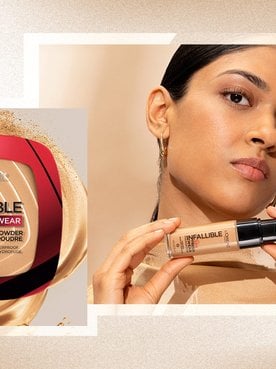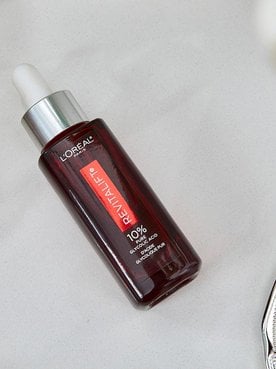There’s always a new skin-care buzzword, but some essentials never change. If you're wondering what are ceramides and why they matter for everyday skin health, you've come to the right place. Ceramides are skin-identical lipids that help fortify your skin barrier, so adding them back through ceramide skincare keeps moisture in and stressors out. Think of them as daily support for comfort, bounce, and a calm-looking complexion.
As your body’s largest organ, skin relies on a strong barrier to defend against environmental stressors and routine wear. When barrier lipids dip, ceramides can help rebalance hydration and reduce visible dryness. Consistent care beats quick fixes, and building a simple routine pays off over time.
Read on to learn what are ceramides, how they work in skincare, the best ingredients to pair with ceramide skincare, and simple ways to add them to your routine.
What Are Ceramides?
To put it simply, your skin cells are the “bricks,” and ceramides are the “mortar” that surrounds them to keep the good stuff in and the bad stuff out. According to the American Journal of Clinical Dermatology, ceramides are waxy lipids found naturally in the outermost layer of skin, where they help seal in water. When levels drop due to age, over-cleansing, or over-exfoliation, skin may look dull and feel tight.
Ceramides make up a significant portion of the barrier’s intercellular lipids. Actually, according to the Journal of Clinical and Aesthetic Dermatology, approximately half of the intercellular lipids in your skin are ceramides, which is why replenishing them supports a smoother look and softer feel. According to the National Center for Biotechnology Information, as we age, the sheer number of ceramides that our body produces decreases, and as a result, the skin can appear dry, and wrinkles can start to set in. Lower ceramide levels can lead to skin sensitivities, irritation, and dullness.
So, if you're wondering what are ceramides good for in daily care, the answer is long-lasting comfort, a more resilient barrier, and a healthier-looking glow. Layering ceramides for skin with hydrating ingredients delivers visible results without heaviness.
How Ceramides Work in Skincare
So now that the first question, what are ceramides, is answered, let’s talk about how they work: Topical ceramides replace the lipids your skin loses over time, re‑filling the barrier’s “mortar” so water stays put and skin looks supple. As they settle into the outer layer, they help tighten the seal between cells, which reduces surface water loss and maintains hydration where you want it. With steady use, ceramides for skin strengthen the barrier, so dryness softens and skin feels calmer. Over time, consistent use of ceramide skincare can visibly reduce dryness, redness, and sensitivity.
Best Ingredients to Pair With Ceramides
Smart pairings amplify benefits and keep routines streamlined. Combining barrier lipids with humectants and skin‑soothers supports hydration while maintaining balance. This is what ceramide cream is designed to do when it plays on a well‑rounded team.
Here are the best combos:
Hyaluronic acid + ceramides
Hyaluronic acid draws water into the skin’s surface layers, while ceramides reinforce the lipid seal that helps prevent that moisture from escaping. Together they create a plump, cushioned look with a soft, dewy finish. The pairing stays lightweight and makeup‑friendly, supporting bounce without heaviness.
Niacinamide + ceramides
Niacinamide supports barrier repair and helps even tone as ceramides strengthen the cushion between skin cells. In tandem, they help skin appear calmer and more resilient with less visible redness over time. The duo suits daily use and complements most routines.
Squalane + ceramides
Squalane provides silky, weightless nourishment that reduces rough feel, while ceramides help maintain that newly smoothed texture. The combination leaves dry zones cushioned and edges soft. It shines in cold weather or dry indoor air by maintaining flexible comfort.
Cholesterol + fatty acids + ceramides
A blend of cholesterol, fatty acids, and ceramides mirrors the skin’s natural lipid matrix. This “triple‑lipid” approach promotes a softer, more flexible feel and supports a resilient barrier. With steady use of ceramides for the face, bounce and evenness visibly improve.
Pairing ceramides with potent actives
Potent actives such as AHAs/BHAs, or retinol increase turnover and can challenge the barrier, especially on sensitive skin. Ceramides buffer this activity by reinforcing lipids and reducing water loss for greater comfort. For example, when you pair retinol and ceramides, skin stays more balanced with fewer signs of irritation.
How Can You Replenish Your Ceramide Levels?
If you're still wondering what is ceramide good for, here's your answer: According to the American Academy of Dermatology Association, moisturizers and serums formulated with ceramides can replenish the skin's barrier lipids while delivering lightweight hydration. This means, if you're feeling your skin sensitive, dry, or want to prevent fine lines, it's time to include ceramides in your routine—and no, you don’t need a prescription from your dermatologist.
If you're ready to add a ceramide face treatment to your routine, try a daily cream like the L’Oréal Paris Bright Reveal Vitamin C Glow Moisturizer. This ceramide cream pairs vitamin C and niacinamide with ceramides to boost glow while supporting the skin barrier. The silky texture layers easily under makeup for a hydrated, radiant finish and comfortable wear.

For a lighter ceramide face cream, smooth onL’Oréal Paris RevitaLift Micro Hyaluronic Acid + Ceramides Line‑Plumping Water Cream to cushion skin with moisture‑binding hyaluronic acid and barrier‑loving ceramides. The refreshing, quick-absorbing formula leaves a soft, non-greasy feel and a bouncy, line-plumping appearance. It is a great pick for dehydrated, dry, or combination skin and sits beautifully under foundation for all‑day comfort.

Finish with broad-spectrum SPF every morning to support and protect your barrier. TheL’Oréal Paris RevitaLift Triple Power Moisturizer with SPF 30 delivers broad‑spectrum SPF 30 with a hydrating cream texture that helps skin look smoother and feel comfortably moisturized. The silky, non‑greasy finish layers well and supports a radiant, even look throughout the day.

Signs you need ceramide skincare in your routine
Here are a few everyday signs your skin barrier wants extra love and care. Use this quick check to decide when to bring a ceramide face moisturizer or serum into the mix—and stick with it to steadily restore comfort and resilience.
Here are the signs you need to watch out for:
- Dry, tight, or itchy skin signals a moisture deficit and a need for barrier-supportive care.
- Flaky or peeling texture: Indicates surface dehydration and disrupted lipid balance.
- Increased sensitivity or redness suggests a stressed barrier that can benefit from ceramide replenishment.
- Products sting or burn easily: Points to a compromised barrier that needs gentle, lipid‑rich formulas.
- Loss of glow or rough texture: Shows water loss at the surface and a need for smoothing hydration.
- Constant dehydration despite moisturizer: A quick note that your barrier may be compromised and needs targeted ceramide care.
FAQs About Ceramide Skincare
What does ceramide do to your skin?
Ceramides replenish the lipids in your outermost layer so water stays in and irritants stay out. With steady use, skin looks smoother and feels calmer with less dryness, tightness, and visible redness.
Which is better, hyaluronic acid or ceramide?
They do different jobs and work best together. Hyaluronic acid attracts water to the surface, while ceramides help seal that hydration in—pairing them supports a plump, comfortable barrier.
What are the 3 essential ceramides?
Many products call out three common ceramides you’ll see on labels: ceramide NP (ceramide 3), ceramide AP (ceramide 6‑II), and ceramide EOP (ceramide 1). They sit between skin cells to help keep them snug, and when they team up with cholesterol and fatty acids, they help rebuild this protective layer so skin feels softer, looks smoother, and stays comfortable.
Next Up: Our Best Skin Firming Products: 7 Picks To Lift, Firm, and Tighten Your Skin
Photo courtesy of L’Oréal Paris.







